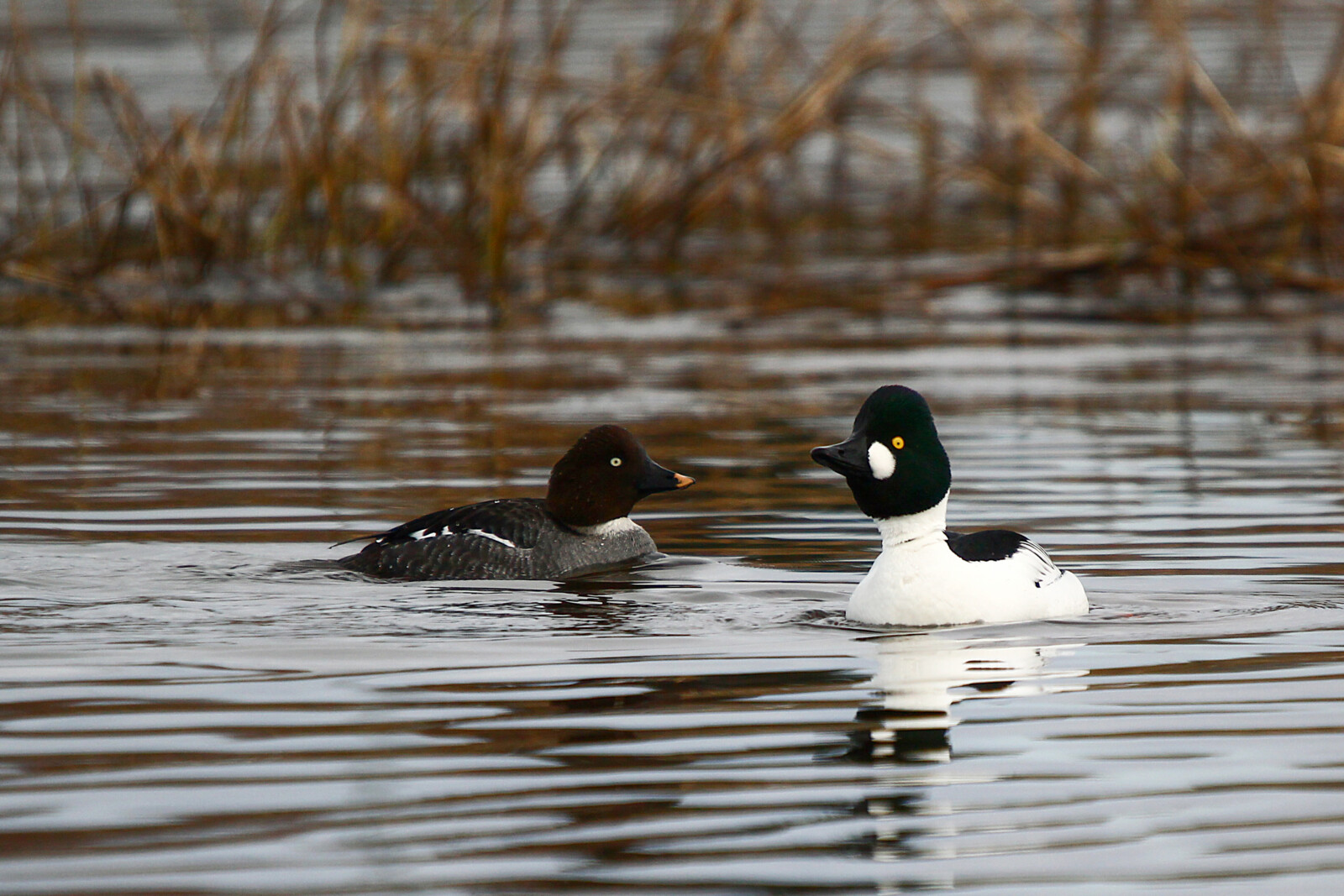Common goldeneye
- Common goldeneye, Matsalu
- https://linnuriik.ee/wp-content/uploads/2021/09/Sotkas-Kauro-Kuik-1024x683.jpg
- Keemu linnud
- https://linnuriik.ee/wp-content/uploads/2021/09/06_Sotkas_090422aa193332_Matsalu.mp3
Common goldeneye. Photo: Kauro Kuik
Introduction
Latin Bucephala clangula (L.)
Estonian Sõtkas
Also known as: goldeneye
Status in Estonia
Breeding, migratory and wintering bird.
Description
The common goldeneye is a medium-sized and stout duck with a big round head. The crown is slightly bushy, making the head appear triangular. The beak is quite small and the secondaries are white while the under-wing is black. The flying is fast, with sharp wing beats. The male bird in definitive plumage has a black head with a green sheen, a huge round white cheek patch, yellow eyes, a bright white breast and sides of the body, the back and most of the top side are black and there are diagonal thin black shoulder stripes across the white side. The female bird has a brown head, light yellow eyes, a white neck and belly, an ash grey breast and sides and a dark beak. A male bird in eclipse plumage resembles a female bird, but the wing pattern is intact, with a lot of white at the front edge. The juvenile is similar to the female bird but has a duller greyish-brown head and no white neck.
Size
Body length 40–48 cm, wingspan 62–77 cm. The male bird is larger than the female bird, weighing on average 900 g, while the female weighs 750 g.
Similar species
Smew.
Distribution
The breeding territory of the common goldeneye in the Northern Hemisphere forest zone is extensive, spanning from Northern China, Mongolia and Russia to boreal forests in Scandinavia and Eastern Europe as well as Canada, the northern parts of the USA and Alaska. The wintering area is similarly extensive, encompassing Northern European coastal areas, Great Britain, inland bodies of water of Southern Europe and the Mediterranean coast as well as Central Asia, Southern China, Japan, Kamchatka, British Columbia Coast and the inland of the United States. In Estonia, the common goldeneye is a common breeding and migratory bird.
Population
About 6000–10,000 pairs breed here while hundreds of thousands migrate through.
Occurrence in Estonia
The autumn migration occurs from the end of August to the end of November, whereas the spring migration occurs from mid-March to May. Males begin their moulting journey in the beginning of June and it lasts until the end of July. The majority of the moulting areas are Suur Väin, the northern portion of the Gulf of Livonia and the area in the Gulf of Finland between Kunda Bay and the Juminda Peninsula. In Estonian waters, tens of thousands of individuals may gather to moult. Between 30,000 and 50,000 common goldeneyes winter here.
Diet
It mostly feeds on invertebrates and less on aquatic plants. It obtains food by diving.
Habitat
The common goldeneye prefers inland water bodies, such as lakes, ponds and rivers as its habitat, in contrast to other Estonian Anatidae. The common goldeneyes spend the winter at sea, frequently alongside long-tailed ducks and common merganser. When winter is warmer, more common goldeneyes spend the winter in our coastal waters.
Nesting
The common goldeneye is the only duck in our region that nests in trees. The nest is made in a variety of hollows, mostly in tree hollows. The female bird lays 7–12 blue-green eggs towards the end of April or early May. If possible, she lays her eggs in the nest of a conspecific or another duck. The clutch can potentially reach 30 eggs due to ‘nest parasitism’. Incubation lasts 28–32 days. After hatching, the chicks are almost immediately capable of obtaining food on their own but require protection. They leave the nest 1–2 days after hatching, with the mother leading the chicks to a body of water. The mother may then leave on her own, leaving the chicks with some other female common goldeneye. If this does not happen, the mother will care for the chicks until they are ready to fly at 56–60 days old. At the end of May, the male birds gather in groups and travel to the sea to moult, leaving just the female bird to care for the young.
Conservation status and protection
The common goldeneye is a gamebird. It is threatened by the pollution of water bodies and disturbance in nesting places. Eagles, falcons and owls are the natural enemies, as are all small predators capable of climbing trees during the nesting season. Not under protection.
Distribution and population in Lääne County
The common goldeneye is a common migratory, breeding and wintering bird in Lääne County. In spring and autumn, a large number of common goldeneyes visit Matsalu and Haapsalu bays. Nesting common goldeneyes can be found on raised bog ponds, manor ponds and woodland lakes. Common goldeneyes typically look for a nesting site in an old black woodpecker’s nest hollow.
In winter, common goldeneyes gather in big flocks along the unfrozen sea coast. The most important wintering areas of common goldeneyes in Lääne County are located around Cape Põõsaspea. Occasionally, nearly a thousand birds winter here.
